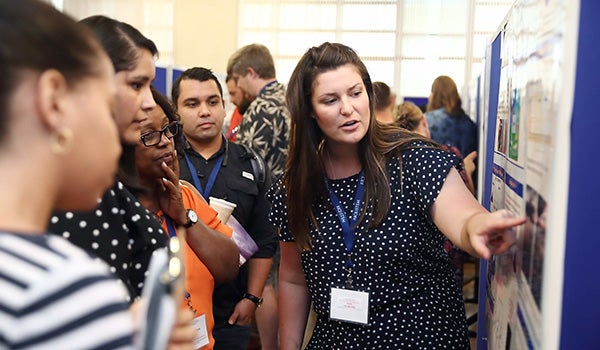This summer, more than 150 teachers, administrators, graduate students, high school students and professors filled Rice University’s Brockman Hall for the 2019 third annual Engineering Research Symposium for Teachers.
Led by the Rice Office of STEM Engagement (R-STEM), the goal of the symposium is to make STEM teachers more aware of current engineering-focused research and to provide them with examples of how to translate that research into classroom lessons or activities.
Each summer, 23 teachers are selected to participate in a six-week internship at either Rice University, Arizona State University or the University of Texas-El Paso to conduct research within various National Science Foundation Engineering Research Collaboratives, such as Nanotechnology Enabled Water Treatment (NEWT) or Precise Advanced Technologies and Health Systems for Underserved Populations (PATHS-UP).
The teacher interns conduct research within a specific problem area under the guidance of a graduate student mentor and learn important aspects of engineering. At the conclusion of the internship, the interns design and present their research poster at the symposium.
This year’s symposium participants also engaged in cutting-edge engineering research discussions lead by Naomi Halas, the Stanley C. Moore Professor of Electrical and Computer Engineering and founding director of the Laboratory for Nanophotonics at Rice; and Reginald DesRoches, dean of Rice’s George R. Brown School of Engineering.
In her talk about the potential uses of nanophotonics, Halas encouraged the crowd of teachers to look toward the future of innovation. Clinical trials on humans suffering from prostate cancer are underway using nanoparticles as agents to destroy the cancerous tissue. Teachers were amazed to learn that so far there have been no reports of any adverse effect from this treatment.

“I feel inspired to learn more about science even though I am a math teacher,” said Demetria Ellis.
In his lecture about the wonders of engineering, DesRoches talked about his amazing journey from Haiti to Rice University. He explained how because of his engineering knowledge he was able to help the people of Haiti after an earthquake rocked that country in 2010. DesRoches served as the key technical leader in the United States’ response to the earthquake, taking a team of 28 engineers, architects, city planners and social scientists to study the impact of the earthquake. After DesRoches’ presentation, teachers discussed how they now plan to convince their principals to allow them to spend more time teaching engineering in the classroom.
To enhance the connection between real-world problems studied in the lab and classroom curriculum, the symposium offered breakout sessions throughout the day on five different hands-on engineering activities. Participants were allowed to choose two breakout sessions during registration based upon grade-level and area of interest.
Sessions included how to engineer glow in the dark slime, how to design a solution for removing pollution from our local bayous and how to develop a code to use a webcam in order to find your heart rate. The rigorous day was designed for teachers to visualize a method for incorporating impactful research within the classroom as a way to engage their students in real-world innovative research.
“We want K–12 students to begin thinking about the next phase of problems that may challenge the future and teachers to think beyond the classroom walls,” said Carolyn Nichol, director of the Rice Office of STEM Engagement.
— Christina Crawford
Associate Director for Science and Engineering
Rice Office of STEM Engagement

